Employee Motivation and Performance: An I/O Psychology Perspective
VerifiedAdded on 2023/01/17
|12
|2643
|28
Report
AI Summary
This report examines the critical role of employee motivation in organizational success, drawing from a news article in the Strait Times and industrial-organizational (I/O) psychology literature. The report explores various motivational strategies, including monetary and non-monetary incentives, opportunities for growth, and creating a positive work environment. It reviews motivational theories such as the expectancy theory, Hertzberg's two-factor theory, goals theory, and the incentive theory, illustrating how these concepts apply to real-world scenarios. A case study from a Philippian business organization is used to demonstrate the positive impact of employee motivation on sales and overall performance. The report emphasizes the importance of employee welfare and highlights how organizations can improve employee engagement and productivity by understanding and implementing effective motivational strategies.

Psychology
I/O in the News: Motivate Employees with an Exciting and Progressive Work Place
Student Name
Institution
Course
Date
I/O in the News: Motivate Employees with an Exciting and Progressive Work Place
Student Name
Institution
Course
Date
Paraphrase This Document
Need a fresh take? Get an instant paraphrase of this document with our AI Paraphraser
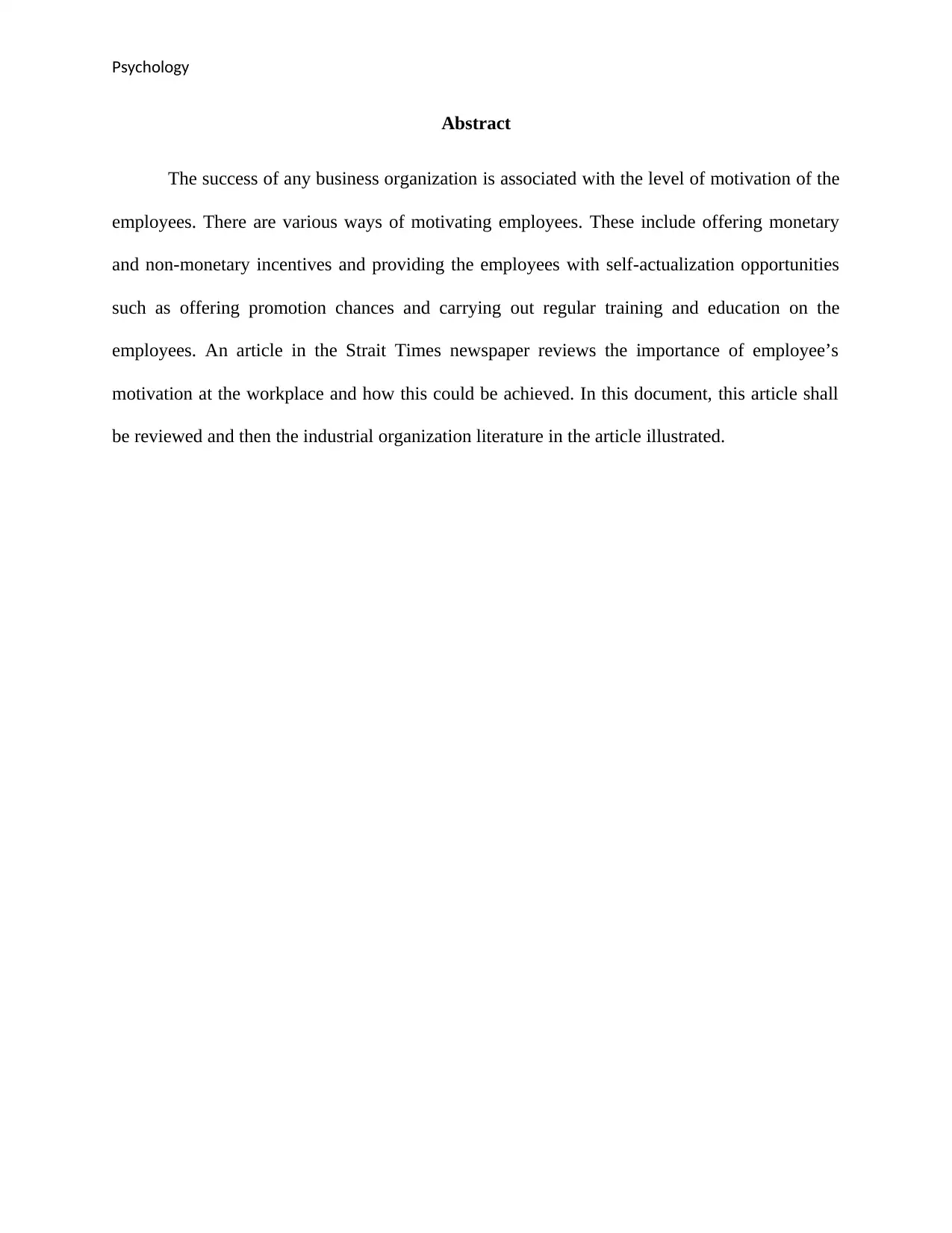
Psychology
Abstract
The success of any business organization is associated with the level of motivation of the
employees. There are various ways of motivating employees. These include offering monetary
and non-monetary incentives and providing the employees with self-actualization opportunities
such as offering promotion chances and carrying out regular training and education on the
employees. An article in the Strait Times newspaper reviews the importance of employee’s
motivation at the workplace and how this could be achieved. In this document, this article shall
be reviewed and then the industrial organization literature in the article illustrated.
Abstract
The success of any business organization is associated with the level of motivation of the
employees. There are various ways of motivating employees. These include offering monetary
and non-monetary incentives and providing the employees with self-actualization opportunities
such as offering promotion chances and carrying out regular training and education on the
employees. An article in the Strait Times newspaper reviews the importance of employee’s
motivation at the workplace and how this could be achieved. In this document, this article shall
be reviewed and then the industrial organization literature in the article illustrated.
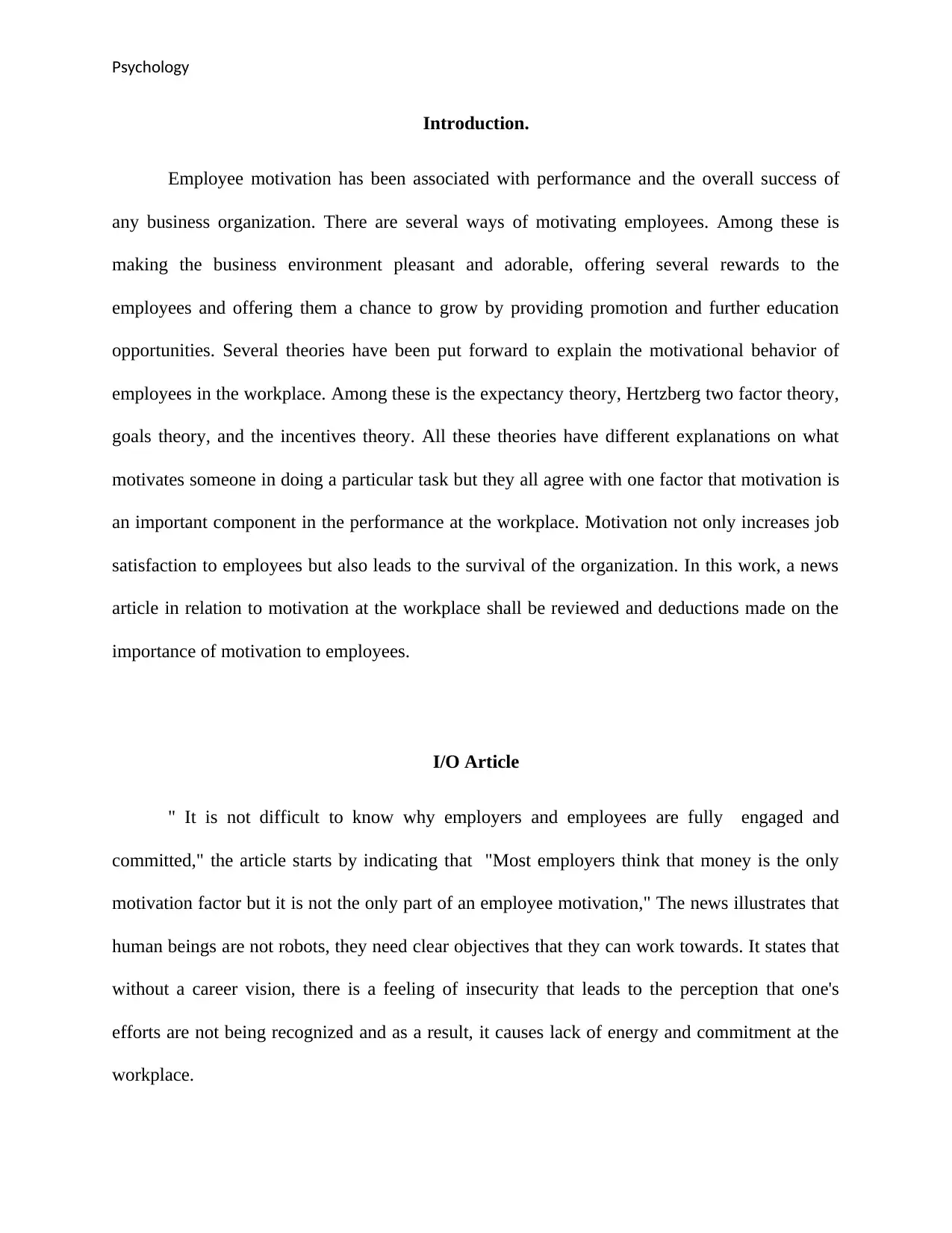
Psychology
Introduction.
Employee motivation has been associated with performance and the overall success of
any business organization. There are several ways of motivating employees. Among these is
making the business environment pleasant and adorable, offering several rewards to the
employees and offering them a chance to grow by providing promotion and further education
opportunities. Several theories have been put forward to explain the motivational behavior of
employees in the workplace. Among these is the expectancy theory, Hertzberg two factor theory,
goals theory, and the incentives theory. All these theories have different explanations on what
motivates someone in doing a particular task but they all agree with one factor that motivation is
an important component in the performance at the workplace. Motivation not only increases job
satisfaction to employees but also leads to the survival of the organization. In this work, a news
article in relation to motivation at the workplace shall be reviewed and deductions made on the
importance of motivation to employees.
I/O Article
" It is not difficult to know why employers and employees are fully engaged and
committed," the article starts by indicating that "Most employers think that money is the only
motivation factor but it is not the only part of an employee motivation," The news illustrates that
human beings are not robots, they need clear objectives that they can work towards. It states that
without a career vision, there is a feeling of insecurity that leads to the perception that one's
efforts are not being recognized and as a result, it causes lack of energy and commitment at the
workplace.
Introduction.
Employee motivation has been associated with performance and the overall success of
any business organization. There are several ways of motivating employees. Among these is
making the business environment pleasant and adorable, offering several rewards to the
employees and offering them a chance to grow by providing promotion and further education
opportunities. Several theories have been put forward to explain the motivational behavior of
employees in the workplace. Among these is the expectancy theory, Hertzberg two factor theory,
goals theory, and the incentives theory. All these theories have different explanations on what
motivates someone in doing a particular task but they all agree with one factor that motivation is
an important component in the performance at the workplace. Motivation not only increases job
satisfaction to employees but also leads to the survival of the organization. In this work, a news
article in relation to motivation at the workplace shall be reviewed and deductions made on the
importance of motivation to employees.
I/O Article
" It is not difficult to know why employers and employees are fully engaged and
committed," the article starts by indicating that "Most employers think that money is the only
motivation factor but it is not the only part of an employee motivation," The news illustrates that
human beings are not robots, they need clear objectives that they can work towards. It states that
without a career vision, there is a feeling of insecurity that leads to the perception that one's
efforts are not being recognized and as a result, it causes lack of energy and commitment at the
workplace.
⊘ This is a preview!⊘
Do you want full access?
Subscribe today to unlock all pages.

Trusted by 1+ million students worldwide
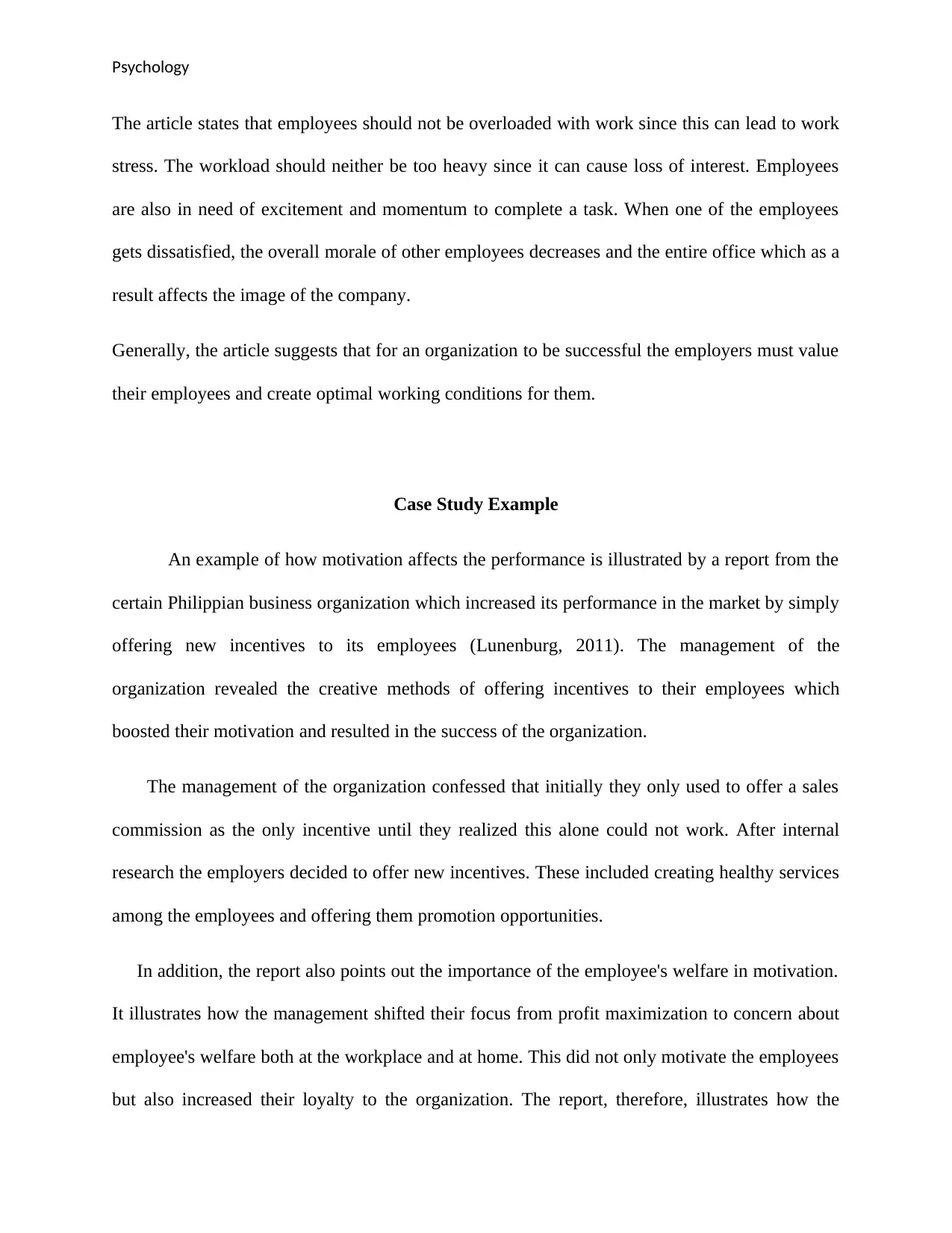
Psychology
The article states that employees should not be overloaded with work since this can lead to work
stress. The workload should neither be too heavy since it can cause loss of interest. Employees
are also in need of excitement and momentum to complete a task. When one of the employees
gets dissatisfied, the overall morale of other employees decreases and the entire office which as a
result affects the image of the company.
Generally, the article suggests that for an organization to be successful the employers must value
their employees and create optimal working conditions for them.
Case Study Example
An example of how motivation affects the performance is illustrated by a report from the
certain Philippian business organization which increased its performance in the market by simply
offering new incentives to its employees (Lunenburg, 2011). The management of the
organization revealed the creative methods of offering incentives to their employees which
boosted their motivation and resulted in the success of the organization.
The management of the organization confessed that initially they only used to offer a sales
commission as the only incentive until they realized this alone could not work. After internal
research the employers decided to offer new incentives. These included creating healthy services
among the employees and offering them promotion opportunities.
In addition, the report also points out the importance of the employee's welfare in motivation.
It illustrates how the management shifted their focus from profit maximization to concern about
employee's welfare both at the workplace and at home. This did not only motivate the employees
but also increased their loyalty to the organization. The report, therefore, illustrates how the
The article states that employees should not be overloaded with work since this can lead to work
stress. The workload should neither be too heavy since it can cause loss of interest. Employees
are also in need of excitement and momentum to complete a task. When one of the employees
gets dissatisfied, the overall morale of other employees decreases and the entire office which as a
result affects the image of the company.
Generally, the article suggests that for an organization to be successful the employers must value
their employees and create optimal working conditions for them.
Case Study Example
An example of how motivation affects the performance is illustrated by a report from the
certain Philippian business organization which increased its performance in the market by simply
offering new incentives to its employees (Lunenburg, 2011). The management of the
organization revealed the creative methods of offering incentives to their employees which
boosted their motivation and resulted in the success of the organization.
The management of the organization confessed that initially they only used to offer a sales
commission as the only incentive until they realized this alone could not work. After internal
research the employers decided to offer new incentives. These included creating healthy services
among the employees and offering them promotion opportunities.
In addition, the report also points out the importance of the employee's welfare in motivation.
It illustrates how the management shifted their focus from profit maximization to concern about
employee's welfare both at the workplace and at home. This did not only motivate the employees
but also increased their loyalty to the organization. The report, therefore, illustrates how the
Paraphrase This Document
Need a fresh take? Get an instant paraphrase of this document with our AI Paraphraser
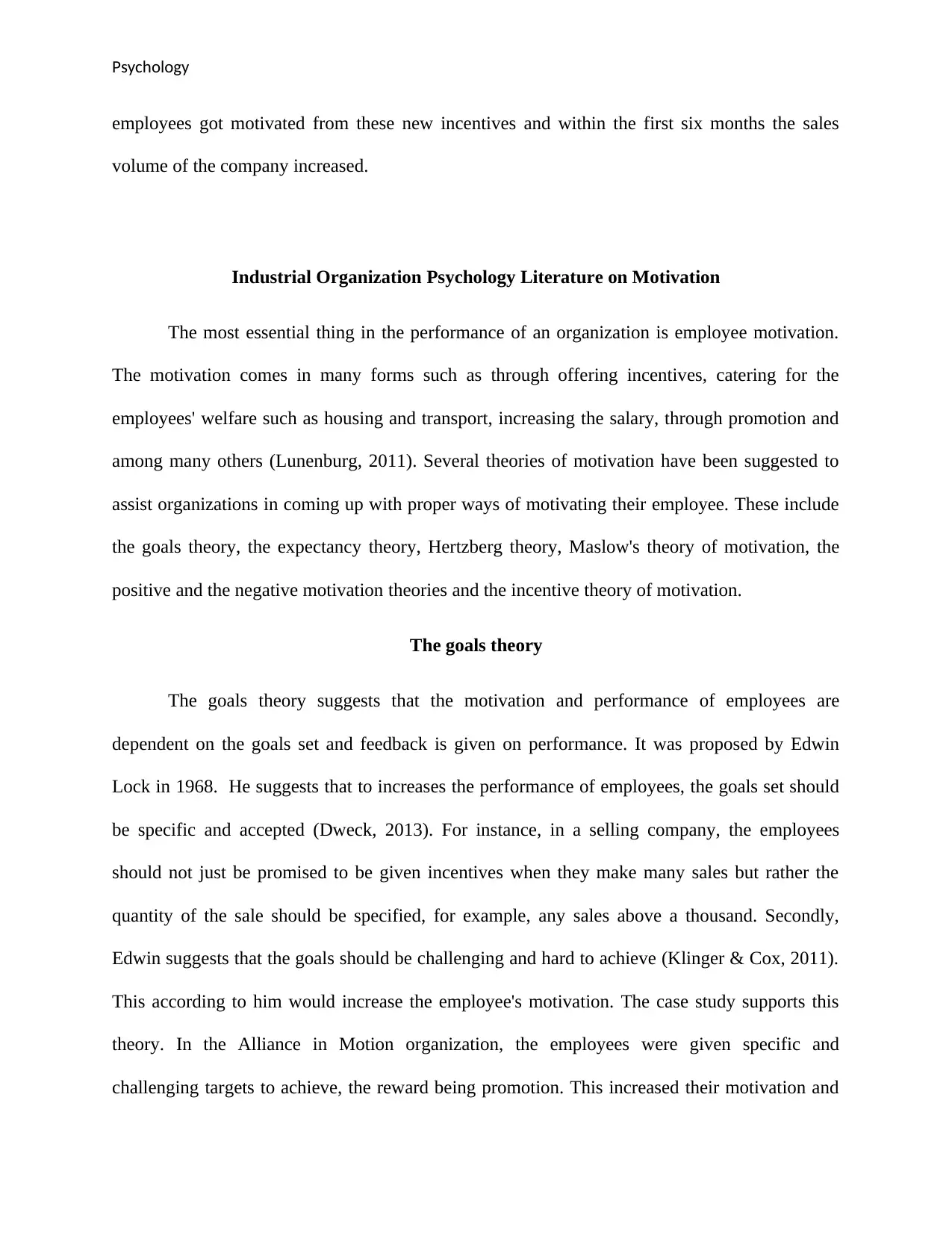
Psychology
employees got motivated from these new incentives and within the first six months the sales
volume of the company increased.
Industrial Organization Psychology Literature on Motivation
The most essential thing in the performance of an organization is employee motivation.
The motivation comes in many forms such as through offering incentives, catering for the
employees' welfare such as housing and transport, increasing the salary, through promotion and
among many others (Lunenburg, 2011). Several theories of motivation have been suggested to
assist organizations in coming up with proper ways of motivating their employee. These include
the goals theory, the expectancy theory, Hertzberg theory, Maslow's theory of motivation, the
positive and the negative motivation theories and the incentive theory of motivation.
The goals theory
The goals theory suggests that the motivation and performance of employees are
dependent on the goals set and feedback is given on performance. It was proposed by Edwin
Lock in 1968. He suggests that to increases the performance of employees, the goals set should
be specific and accepted (Dweck, 2013). For instance, in a selling company, the employees
should not just be promised to be given incentives when they make many sales but rather the
quantity of the sale should be specified, for example, any sales above a thousand. Secondly,
Edwin suggests that the goals should be challenging and hard to achieve (Klinger & Cox, 2011).
This according to him would increase the employee's motivation. The case study supports this
theory. In the Alliance in Motion organization, the employees were given specific and
challenging targets to achieve, the reward being promotion. This increased their motivation and
employees got motivated from these new incentives and within the first six months the sales
volume of the company increased.
Industrial Organization Psychology Literature on Motivation
The most essential thing in the performance of an organization is employee motivation.
The motivation comes in many forms such as through offering incentives, catering for the
employees' welfare such as housing and transport, increasing the salary, through promotion and
among many others (Lunenburg, 2011). Several theories of motivation have been suggested to
assist organizations in coming up with proper ways of motivating their employee. These include
the goals theory, the expectancy theory, Hertzberg theory, Maslow's theory of motivation, the
positive and the negative motivation theories and the incentive theory of motivation.
The goals theory
The goals theory suggests that the motivation and performance of employees are
dependent on the goals set and feedback is given on performance. It was proposed by Edwin
Lock in 1968. He suggests that to increases the performance of employees, the goals set should
be specific and accepted (Dweck, 2013). For instance, in a selling company, the employees
should not just be promised to be given incentives when they make many sales but rather the
quantity of the sale should be specified, for example, any sales above a thousand. Secondly,
Edwin suggests that the goals should be challenging and hard to achieve (Klinger & Cox, 2011).
This according to him would increase the employee's motivation. The case study supports this
theory. In the Alliance in Motion organization, the employees were given specific and
challenging targets to achieve, the reward being promotion. This increased their motivation and
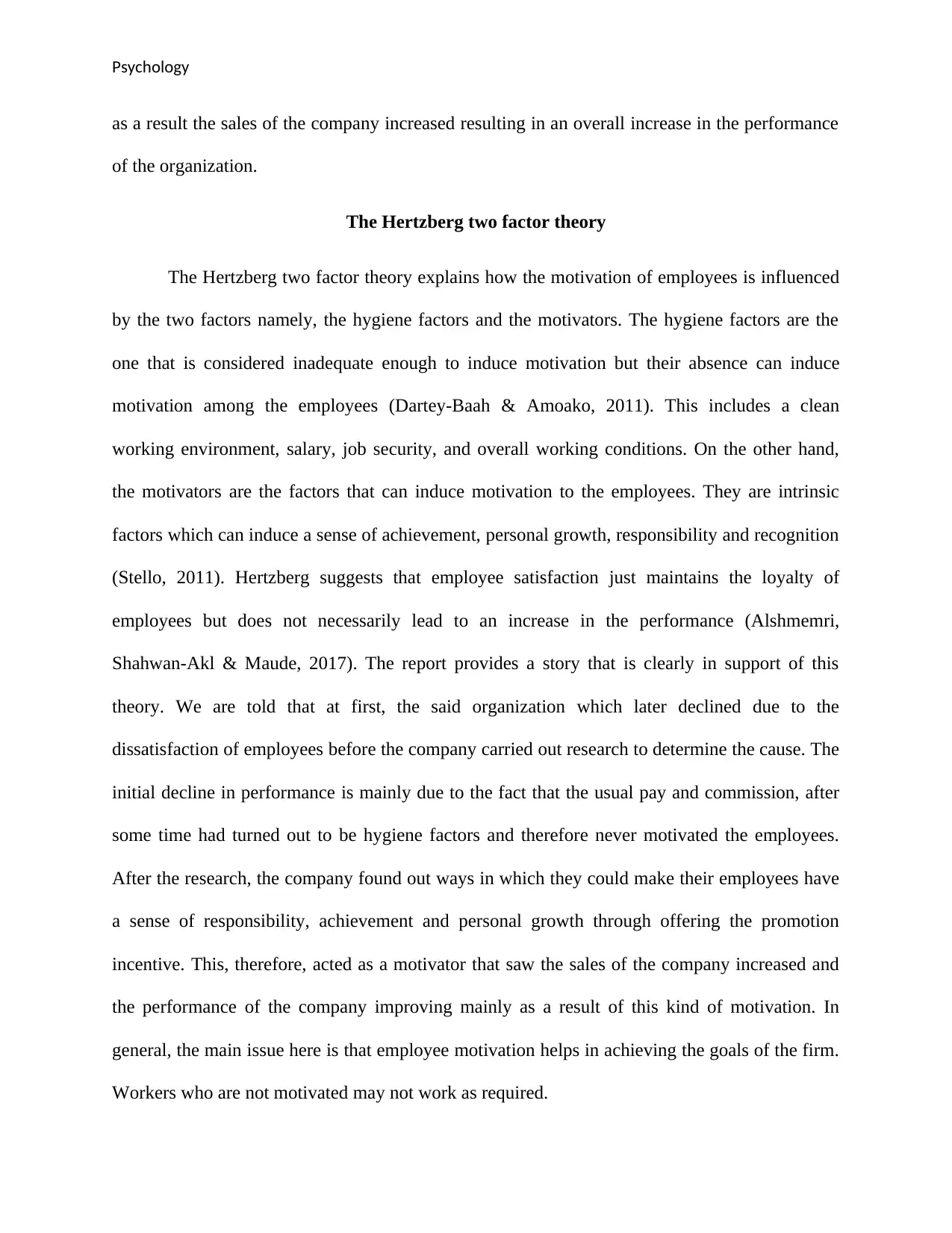
Psychology
as a result the sales of the company increased resulting in an overall increase in the performance
of the organization.
The Hertzberg two factor theory
The Hertzberg two factor theory explains how the motivation of employees is influenced
by the two factors namely, the hygiene factors and the motivators. The hygiene factors are the
one that is considered inadequate enough to induce motivation but their absence can induce
motivation among the employees (Dartey-Baah & Amoako, 2011). This includes a clean
working environment, salary, job security, and overall working conditions. On the other hand,
the motivators are the factors that can induce motivation to the employees. They are intrinsic
factors which can induce a sense of achievement, personal growth, responsibility and recognition
(Stello, 2011). Hertzberg suggests that employee satisfaction just maintains the loyalty of
employees but does not necessarily lead to an increase in the performance (Alshmemri,
Shahwan-Akl & Maude, 2017). The report provides a story that is clearly in support of this
theory. We are told that at first, the said organization which later declined due to the
dissatisfaction of employees before the company carried out research to determine the cause. The
initial decline in performance is mainly due to the fact that the usual pay and commission, after
some time had turned out to be hygiene factors and therefore never motivated the employees.
After the research, the company found out ways in which they could make their employees have
a sense of responsibility, achievement and personal growth through offering the promotion
incentive. This, therefore, acted as a motivator that saw the sales of the company increased and
the performance of the company improving mainly as a result of this kind of motivation. In
general, the main issue here is that employee motivation helps in achieving the goals of the firm.
Workers who are not motivated may not work as required.
as a result the sales of the company increased resulting in an overall increase in the performance
of the organization.
The Hertzberg two factor theory
The Hertzberg two factor theory explains how the motivation of employees is influenced
by the two factors namely, the hygiene factors and the motivators. The hygiene factors are the
one that is considered inadequate enough to induce motivation but their absence can induce
motivation among the employees (Dartey-Baah & Amoako, 2011). This includes a clean
working environment, salary, job security, and overall working conditions. On the other hand,
the motivators are the factors that can induce motivation to the employees. They are intrinsic
factors which can induce a sense of achievement, personal growth, responsibility and recognition
(Stello, 2011). Hertzberg suggests that employee satisfaction just maintains the loyalty of
employees but does not necessarily lead to an increase in the performance (Alshmemri,
Shahwan-Akl & Maude, 2017). The report provides a story that is clearly in support of this
theory. We are told that at first, the said organization which later declined due to the
dissatisfaction of employees before the company carried out research to determine the cause. The
initial decline in performance is mainly due to the fact that the usual pay and commission, after
some time had turned out to be hygiene factors and therefore never motivated the employees.
After the research, the company found out ways in which they could make their employees have
a sense of responsibility, achievement and personal growth through offering the promotion
incentive. This, therefore, acted as a motivator that saw the sales of the company increased and
the performance of the company improving mainly as a result of this kind of motivation. In
general, the main issue here is that employee motivation helps in achieving the goals of the firm.
Workers who are not motivated may not work as required.
⊘ This is a preview!⊘
Do you want full access?
Subscribe today to unlock all pages.

Trusted by 1+ million students worldwide
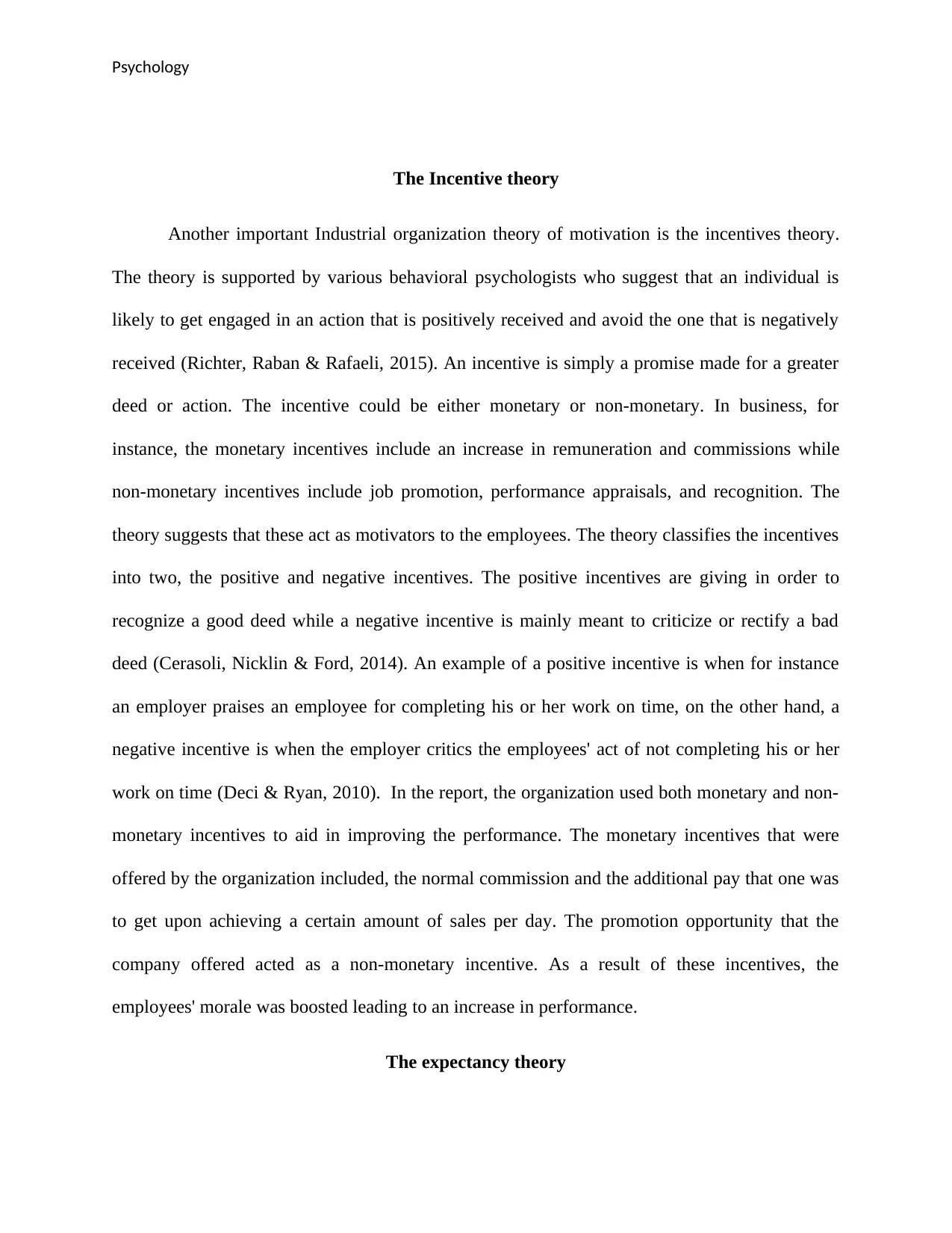
Psychology
The Incentive theory
Another important Industrial organization theory of motivation is the incentives theory.
The theory is supported by various behavioral psychologists who suggest that an individual is
likely to get engaged in an action that is positively received and avoid the one that is negatively
received (Richter, Raban & Rafaeli, 2015). An incentive is simply a promise made for a greater
deed or action. The incentive could be either monetary or non-monetary. In business, for
instance, the monetary incentives include an increase in remuneration and commissions while
non-monetary incentives include job promotion, performance appraisals, and recognition. The
theory suggests that these act as motivators to the employees. The theory classifies the incentives
into two, the positive and negative incentives. The positive incentives are giving in order to
recognize a good deed while a negative incentive is mainly meant to criticize or rectify a bad
deed (Cerasoli, Nicklin & Ford, 2014). An example of a positive incentive is when for instance
an employer praises an employee for completing his or her work on time, on the other hand, a
negative incentive is when the employer critics the employees' act of not completing his or her
work on time (Deci & Ryan, 2010). In the report, the organization used both monetary and non-
monetary incentives to aid in improving the performance. The monetary incentives that were
offered by the organization included, the normal commission and the additional pay that one was
to get upon achieving a certain amount of sales per day. The promotion opportunity that the
company offered acted as a non-monetary incentive. As a result of these incentives, the
employees' morale was boosted leading to an increase in performance.
The expectancy theory
The Incentive theory
Another important Industrial organization theory of motivation is the incentives theory.
The theory is supported by various behavioral psychologists who suggest that an individual is
likely to get engaged in an action that is positively received and avoid the one that is negatively
received (Richter, Raban & Rafaeli, 2015). An incentive is simply a promise made for a greater
deed or action. The incentive could be either monetary or non-monetary. In business, for
instance, the monetary incentives include an increase in remuneration and commissions while
non-monetary incentives include job promotion, performance appraisals, and recognition. The
theory suggests that these act as motivators to the employees. The theory classifies the incentives
into two, the positive and negative incentives. The positive incentives are giving in order to
recognize a good deed while a negative incentive is mainly meant to criticize or rectify a bad
deed (Cerasoli, Nicklin & Ford, 2014). An example of a positive incentive is when for instance
an employer praises an employee for completing his or her work on time, on the other hand, a
negative incentive is when the employer critics the employees' act of not completing his or her
work on time (Deci & Ryan, 2010). In the report, the organization used both monetary and non-
monetary incentives to aid in improving the performance. The monetary incentives that were
offered by the organization included, the normal commission and the additional pay that one was
to get upon achieving a certain amount of sales per day. The promotion opportunity that the
company offered acted as a non-monetary incentive. As a result of these incentives, the
employees' morale was boosted leading to an increase in performance.
The expectancy theory
Paraphrase This Document
Need a fresh take? Get an instant paraphrase of this document with our AI Paraphraser

Psychology
This theory suggests that individuals would always work according to the conscious
expectation that particular behavior would lead to a certain desirable reward. It was developed by
Victor Vroom in 1964 when he was trying to develop a systematic explanation for motivation at
the workplace (Renko, Kroeck & Bullough, 2012). Victor suggests that the theory has three
components, expectancy, instrumentality, and valence. Expectancy refers to one's belief that his
or her actions can lead to the attainment of a certain objective (Wigfield & Cambria, 2010).
Instrumentality, on the other hand, refers to the one's belief in getting a reward after attaining a
particular goal while valence refers to how the person values the reward, is it attractive or not
attractive (Nagengast et al., 2011) When all these three factors are availed, the employee is
motivated and the performance increases. The story in the report illustrates the applicability of
this theory. The organization set goals which were challenging but attainable in the eyes of the
employees, an aspect of expectancy. The employees were motivated when they realized that the
promised incentives were implemented. This built trust between the employees and the
management and therefore the employees were certain to be rewarded after an exemplary
performance, an aspect of instrumentality.
My opinion
An important factor for employee performance in an organization is motivation.
Motivation can be achieved in a number of ways. These include through offering incentives such
as increasing remuneration, job promotion, performance appraisal, through having a concern in
the employees' welfare such as by improving the working conditions and through development
opportunities to the employees such as the opportunity for further education. Different theories
have different suggestions on the factors that lead to the satisfaction and dissatisfaction of
employees but they all agree on the factor that employee motivation is essential in performance.
This theory suggests that individuals would always work according to the conscious
expectation that particular behavior would lead to a certain desirable reward. It was developed by
Victor Vroom in 1964 when he was trying to develop a systematic explanation for motivation at
the workplace (Renko, Kroeck & Bullough, 2012). Victor suggests that the theory has three
components, expectancy, instrumentality, and valence. Expectancy refers to one's belief that his
or her actions can lead to the attainment of a certain objective (Wigfield & Cambria, 2010).
Instrumentality, on the other hand, refers to the one's belief in getting a reward after attaining a
particular goal while valence refers to how the person values the reward, is it attractive or not
attractive (Nagengast et al., 2011) When all these three factors are availed, the employee is
motivated and the performance increases. The story in the report illustrates the applicability of
this theory. The organization set goals which were challenging but attainable in the eyes of the
employees, an aspect of expectancy. The employees were motivated when they realized that the
promised incentives were implemented. This built trust between the employees and the
management and therefore the employees were certain to be rewarded after an exemplary
performance, an aspect of instrumentality.
My opinion
An important factor for employee performance in an organization is motivation.
Motivation can be achieved in a number of ways. These include through offering incentives such
as increasing remuneration, job promotion, performance appraisal, through having a concern in
the employees' welfare such as by improving the working conditions and through development
opportunities to the employees such as the opportunity for further education. Different theories
have different suggestions on the factors that lead to the satisfaction and dissatisfaction of
employees but they all agree on the factor that employee motivation is essential in performance.
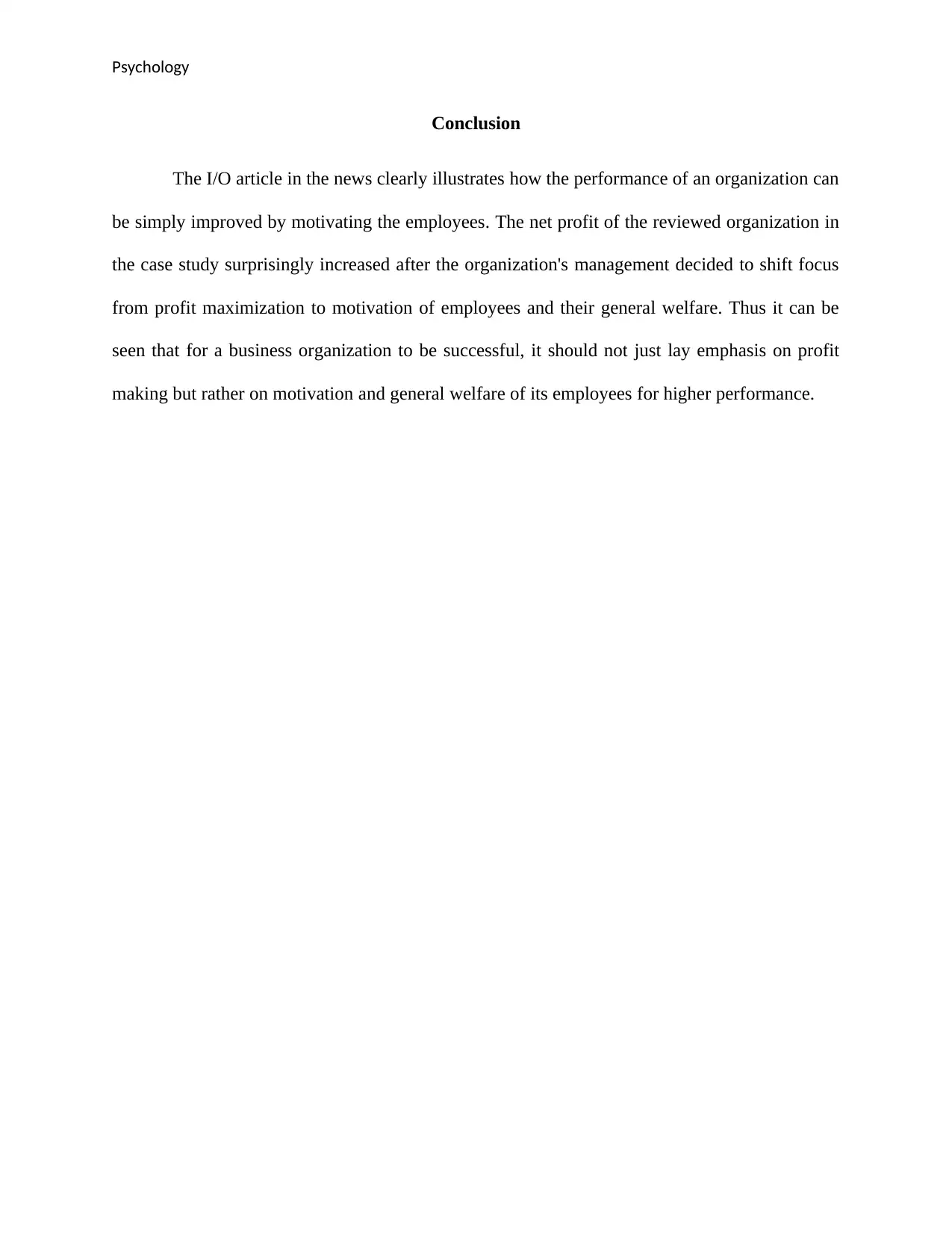
Psychology
Conclusion
The I/O article in the news clearly illustrates how the performance of an organization can
be simply improved by motivating the employees. The net profit of the reviewed organization in
the case study surprisingly increased after the organization's management decided to shift focus
from profit maximization to motivation of employees and their general welfare. Thus it can be
seen that for a business organization to be successful, it should not just lay emphasis on profit
making but rather on motivation and general welfare of its employees for higher performance.
Conclusion
The I/O article in the news clearly illustrates how the performance of an organization can
be simply improved by motivating the employees. The net profit of the reviewed organization in
the case study surprisingly increased after the organization's management decided to shift focus
from profit maximization to motivation of employees and their general welfare. Thus it can be
seen that for a business organization to be successful, it should not just lay emphasis on profit
making but rather on motivation and general welfare of its employees for higher performance.
⊘ This is a preview!⊘
Do you want full access?
Subscribe today to unlock all pages.

Trusted by 1+ million students worldwide
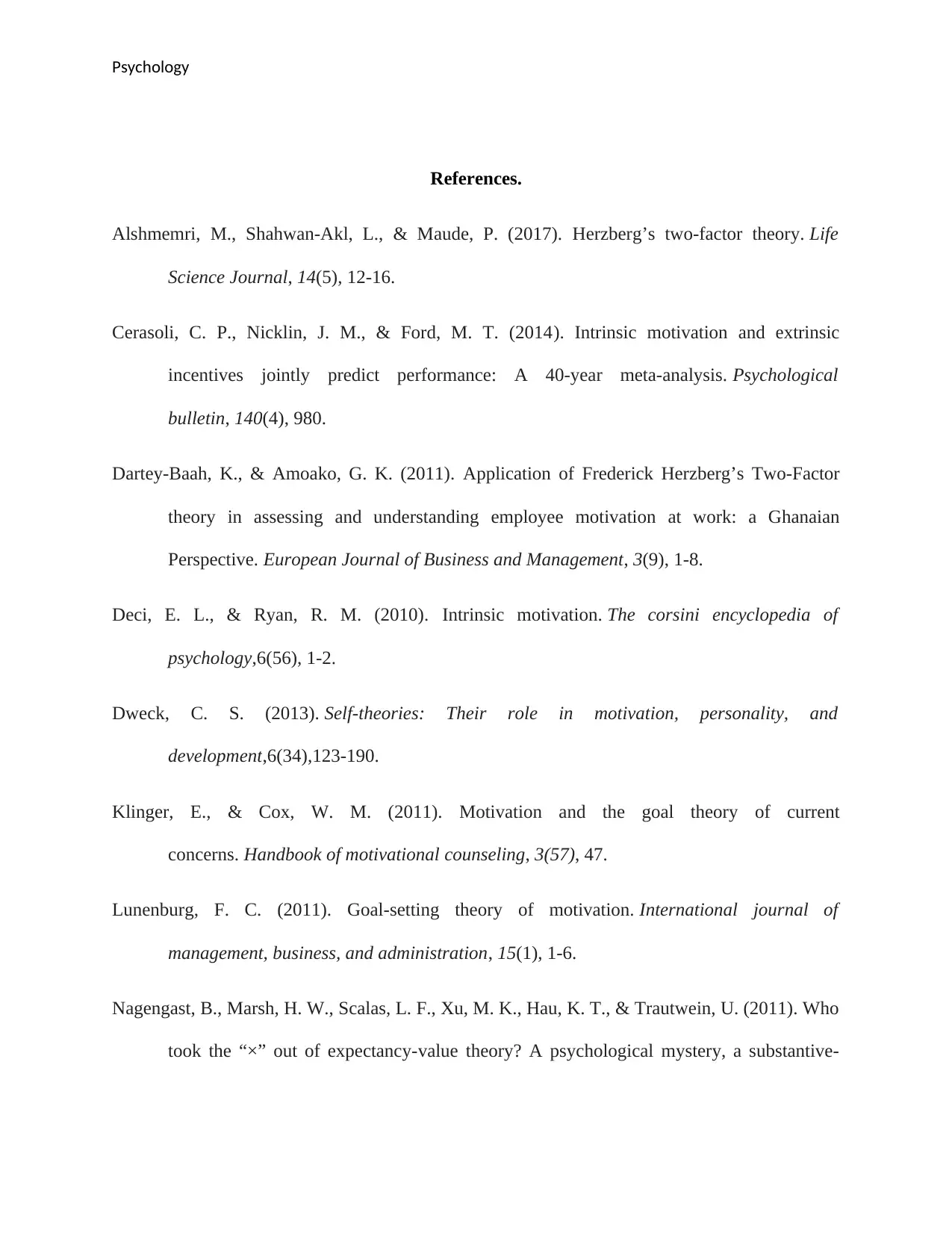
Psychology
References.
Alshmemri, M., Shahwan-Akl, L., & Maude, P. (2017). Herzberg’s two-factor theory. Life
Science Journal, 14(5), 12-16.
Cerasoli, C. P., Nicklin, J. M., & Ford, M. T. (2014). Intrinsic motivation and extrinsic
incentives jointly predict performance: A 40-year meta-analysis. Psychological
bulletin, 140(4), 980.
Dartey-Baah, K., & Amoako, G. K. (2011). Application of Frederick Herzberg’s Two-Factor
theory in assessing and understanding employee motivation at work: a Ghanaian
Perspective. European Journal of Business and Management, 3(9), 1-8.
Deci, E. L., & Ryan, R. M. (2010). Intrinsic motivation. The corsini encyclopedia of
psychology,6(56), 1-2.
Dweck, C. S. (2013). Self-theories: Their role in motivation, personality, and
development,6(34),123-190.
Klinger, E., & Cox, W. M. (2011). Motivation and the goal theory of current
concerns. Handbook of motivational counseling, 3(57), 47.
Lunenburg, F. C. (2011). Goal-setting theory of motivation. International journal of
management, business, and administration, 15(1), 1-6.
Nagengast, B., Marsh, H. W., Scalas, L. F., Xu, M. K., Hau, K. T., & Trautwein, U. (2011). Who
took the “×” out of expectancy-value theory? A psychological mystery, a substantive-
References.
Alshmemri, M., Shahwan-Akl, L., & Maude, P. (2017). Herzberg’s two-factor theory. Life
Science Journal, 14(5), 12-16.
Cerasoli, C. P., Nicklin, J. M., & Ford, M. T. (2014). Intrinsic motivation and extrinsic
incentives jointly predict performance: A 40-year meta-analysis. Psychological
bulletin, 140(4), 980.
Dartey-Baah, K., & Amoako, G. K. (2011). Application of Frederick Herzberg’s Two-Factor
theory in assessing and understanding employee motivation at work: a Ghanaian
Perspective. European Journal of Business and Management, 3(9), 1-8.
Deci, E. L., & Ryan, R. M. (2010). Intrinsic motivation. The corsini encyclopedia of
psychology,6(56), 1-2.
Dweck, C. S. (2013). Self-theories: Their role in motivation, personality, and
development,6(34),123-190.
Klinger, E., & Cox, W. M. (2011). Motivation and the goal theory of current
concerns. Handbook of motivational counseling, 3(57), 47.
Lunenburg, F. C. (2011). Goal-setting theory of motivation. International journal of
management, business, and administration, 15(1), 1-6.
Nagengast, B., Marsh, H. W., Scalas, L. F., Xu, M. K., Hau, K. T., & Trautwein, U. (2011). Who
took the “×” out of expectancy-value theory? A psychological mystery, a substantive-
Paraphrase This Document
Need a fresh take? Get an instant paraphrase of this document with our AI Paraphraser
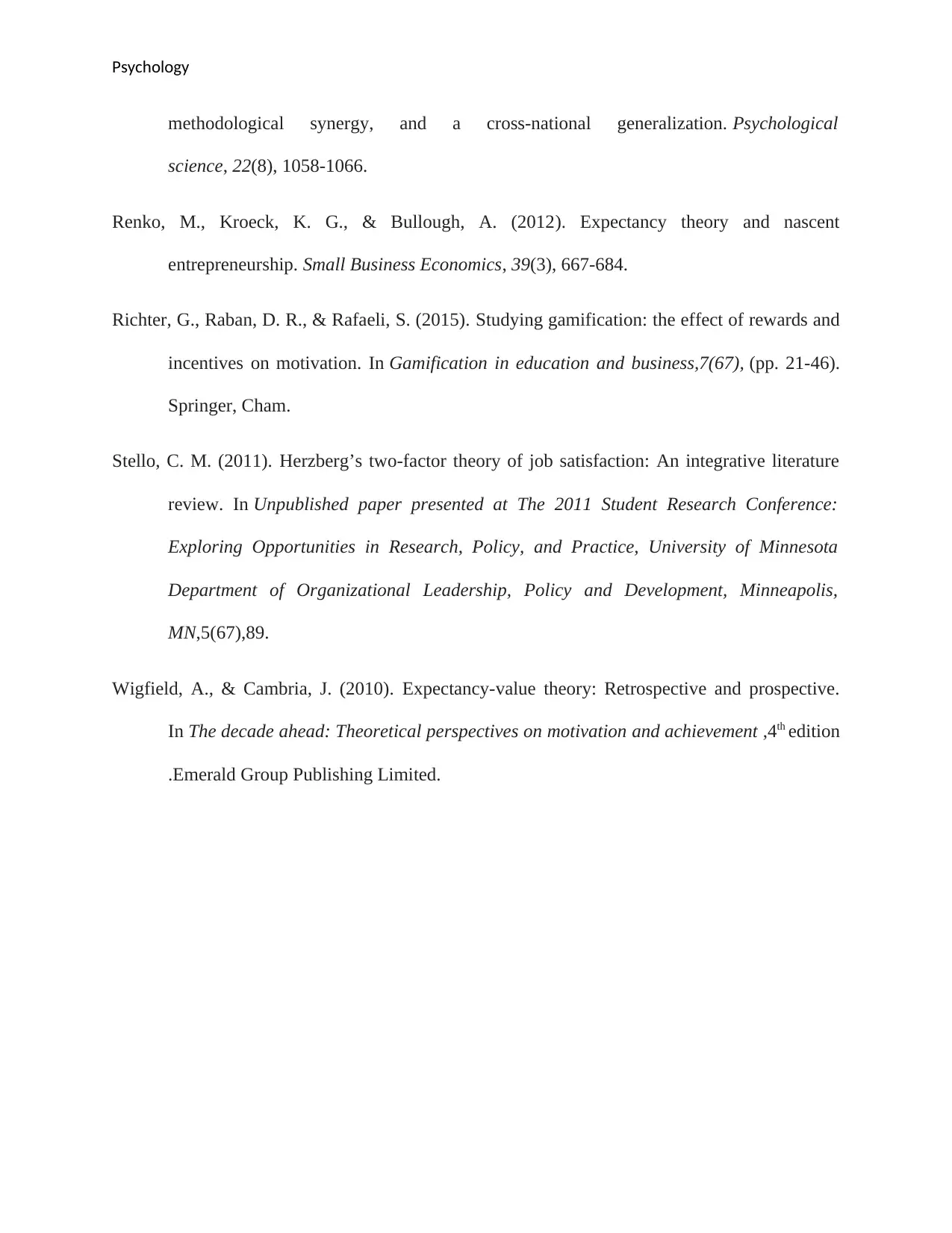
Psychology
methodological synergy, and a cross-national generalization. Psychological
science, 22(8), 1058-1066.
Renko, M., Kroeck, K. G., & Bullough, A. (2012). Expectancy theory and nascent
entrepreneurship. Small Business Economics, 39(3), 667-684.
Richter, G., Raban, D. R., & Rafaeli, S. (2015). Studying gamification: the effect of rewards and
incentives on motivation. In Gamification in education and business,7(67), (pp. 21-46).
Springer, Cham.
Stello, C. M. (2011). Herzberg’s two-factor theory of job satisfaction: An integrative literature
review. In Unpublished paper presented at The 2011 Student Research Conference:
Exploring Opportunities in Research, Policy, and Practice, University of Minnesota
Department of Organizational Leadership, Policy and Development, Minneapolis,
MN,5(67),89.
Wigfield, A., & Cambria, J. (2010). Expectancy-value theory: Retrospective and prospective.
In The decade ahead: Theoretical perspectives on motivation and achievement ,4th edition
.Emerald Group Publishing Limited.
methodological synergy, and a cross-national generalization. Psychological
science, 22(8), 1058-1066.
Renko, M., Kroeck, K. G., & Bullough, A. (2012). Expectancy theory and nascent
entrepreneurship. Small Business Economics, 39(3), 667-684.
Richter, G., Raban, D. R., & Rafaeli, S. (2015). Studying gamification: the effect of rewards and
incentives on motivation. In Gamification in education and business,7(67), (pp. 21-46).
Springer, Cham.
Stello, C. M. (2011). Herzberg’s two-factor theory of job satisfaction: An integrative literature
review. In Unpublished paper presented at The 2011 Student Research Conference:
Exploring Opportunities in Research, Policy, and Practice, University of Minnesota
Department of Organizational Leadership, Policy and Development, Minneapolis,
MN,5(67),89.
Wigfield, A., & Cambria, J. (2010). Expectancy-value theory: Retrospective and prospective.
In The decade ahead: Theoretical perspectives on motivation and achievement ,4th edition
.Emerald Group Publishing Limited.
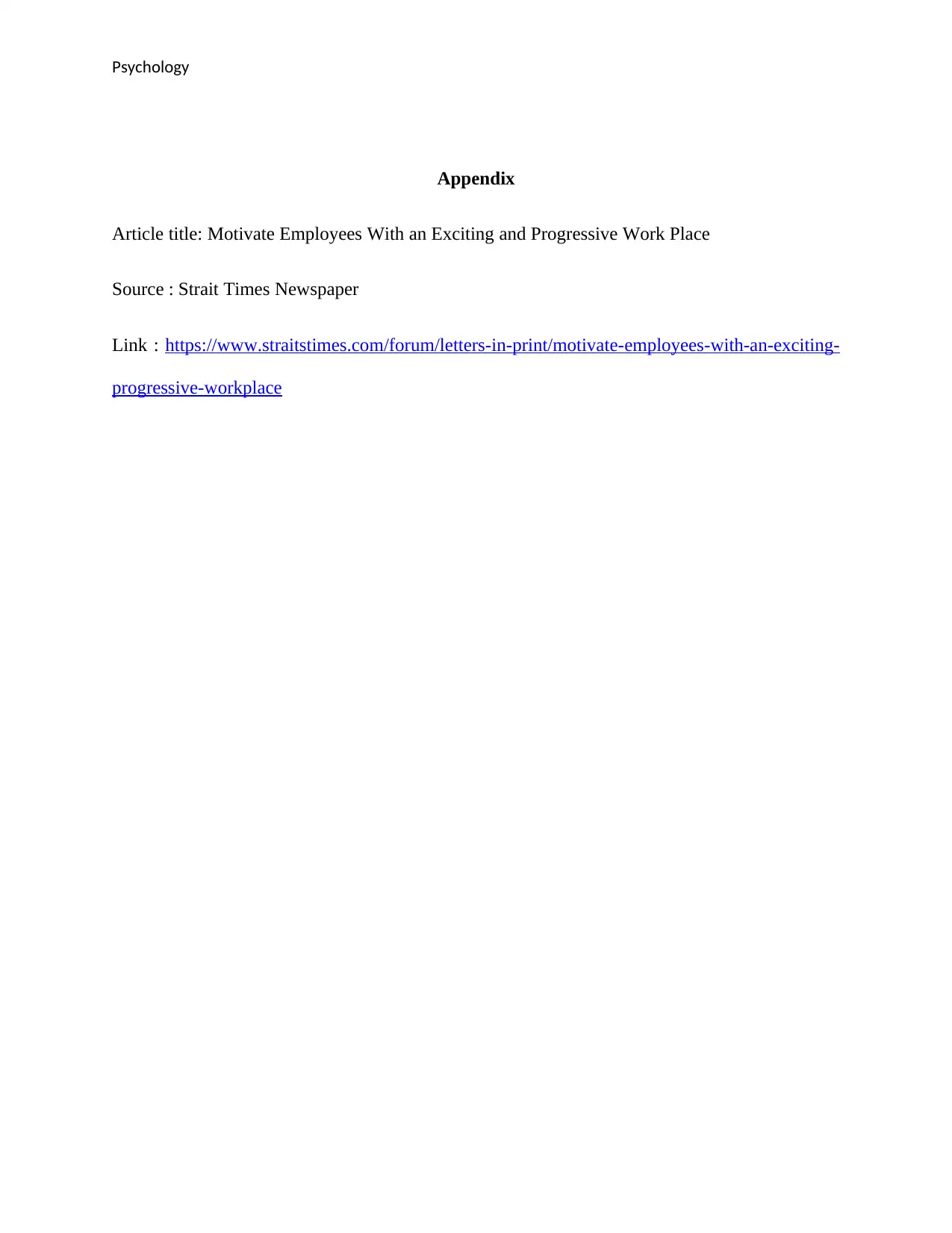
Psychology
Appendix
Article title: Motivate Employees With an Exciting and Progressive Work Place
Source : Strait Times Newspaper
Link : https://www.straitstimes.com/forum/letters-in-print/motivate-employees-with-an-exciting-
progressive-workplace
Appendix
Article title: Motivate Employees With an Exciting and Progressive Work Place
Source : Strait Times Newspaper
Link : https://www.straitstimes.com/forum/letters-in-print/motivate-employees-with-an-exciting-
progressive-workplace
⊘ This is a preview!⊘
Do you want full access?
Subscribe today to unlock all pages.

Trusted by 1+ million students worldwide
1 out of 12
Related Documents
Your All-in-One AI-Powered Toolkit for Academic Success.
+13062052269
info@desklib.com
Available 24*7 on WhatsApp / Email
![[object Object]](/_next/static/media/star-bottom.7253800d.svg)
Unlock your academic potential
Copyright © 2020–2026 A2Z Services. All Rights Reserved. Developed and managed by ZUCOL.





